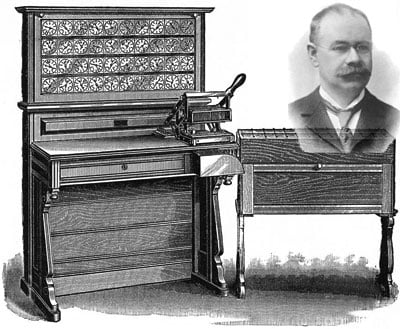Evolution of computers:
Evolution of computers:

Napier ’s Bones(1614s):
Pascaline(1642s):
Difference Engine(1820s):
Boolean Logic(1850s):
Tabulator(1890s):

The Mark Computer(1937-44):
The Atanasoff-Berry Computer(1939-42):
 ENIAC:
ENIAC:

Necessity is the mother of invention.This hold the true for computers.The word COMPUTER was first used in a book named as ”The Young Mans Gleanings” written by English writer Richard Braithwait.
“Who invented the computer?” is not a simple one. Because it is not a single machine but a collection of different complicated parts,so development of each part can be considered as a separate invention. Many Scientists have contributed to the history of computers.
Abacus:
Many centuries ago when man started to count the numbers, he thought of a device which can trace the numbers and thus came the existence of ABACUS. It was the first counting device which was developed in China more than 3000 years ago. The name Abacus was obtained from Greek word Abax which means slab. This device basically consists of a rectangular wooden frame and beads.

Napier ’s Bones(1614s):
It is a device which contains a set of rods made of bones. It was developed by John Napier, a Scottish Mathematician and hence the device was named as Napier’s Bones. The device was mainly developed for performing multiplication and division. Later in 1614 he also introduced logarithms.
Pascaline(1642s):
Pascaline, also called Arithmetic Machine, the first calculator or adding machine to be produced in any quantity and actually used. The Pascaline was designed and built by the French mathematician-philosopher Blaise Pascal between 1642 and 1644. It could only do addition and subtraction, with numbers being entered by manipulating its dials. Pascal invented the machine for his father, a tax collector, so it was the first business machine too (if one does not count the abacus). He built 50 of them over the next 10 years.
Difference Engine(1820s):
It an early calculating machine, verging on being the first computer, designed and partially built during the 1820s and ’30s by Charles Babbage. Babbage was an English mathematician and inventor; he invented the cowcatcher, reformed the British postal system, and was a pioneer in the fields of operations research and actuarial science. It was Babbage who first suggested that the weather of years past could be read from tree rings. He also had a lifelong fascination with keys, ciphers, and mechanical dolls (automatons).
Boolean Logic(1850s):
George Boole is considered the world’s most influential mathematician of the 19th century. George Boole wrote the book “The Mathematical Analysis of Logic” in 1847. Boolean algebra eventually led to the digital revolution. It is used for design of computer circuitry.
Tabulator(1890s):
Dr. Herman Hollerith introduce the first electromecahanical punched card data processing machine which was used to compile information for the 1890U.S. cencus. Hollerith's tabulator become so successful that he started his own business to market it.His company would eventually become International business machine(IBM).

The Mark Computer(1937-44):
It known as Automatic Sequence Controlled calculator.This was full automatic calculating machine design by Harvard Aiken collaboration with engineers of IBM. It is specially built in programs for logarithms and trigonometric.
The Atanasoff-Berry Computer(1939-42):
Dr. John Atanasoff developed an electronic machine to solve mathematical equations.The machine was called the Atanasoff-Berry Computer, or ABC.It used 45 vacuum tubes internal logic and capacitors for storage.

Electronic Numerical Integrator and Calculator, the ENIAC was the first electronic computer used for general purposes, such as solving numerical problems.It was developed by Jown W.Mauchly And J.Presper Eckertat at the University of Pennsylvania to calculate artillery firing tables for the United States Army's Ballistic Research Laboratory. It used 18000 vacuum tubes,punch card input weighted 30 tons and occupied by 30*40 foot space.

EDVAC(1946-52):
The major draw back of ENIAC was that its programmed were wired on board that made it difficult to to change the programs.Dr. john Von Neumann later introduced the "stored program concept" that helped in overcoming this problem.This computer was called by acronym EDVAC (Electronic Discrete Variable Automatic Computer).This machine should be abel to hold any programme in memory that was fed to it
EDSAC(1947-49):
Electronic Delay Storage Automatic Calculator, EDSAC is an early British computer considered to be the first stored program electronic computer. It was created at the University of Cambridge in England, performed its first calculation on May 6, 1949, and was the computer that ran the first graphical computer game, nicknamed "Baby." In the picture to the right, is an example of the EDSAC computer.
UNIVAC I(1951):
Universal Automatic Computer, the UNIVAC I, a trademark of the Unisys corporation, was released in 1951 and 1952 when first developed by J. Presper Eckert and John Mauchly. The UNIVAC is an electrical computer containing thousands of vacuum tubes that utilizes punch cards and switches for inputting data and punch cards for outputting and storing data.
Transistor Computers(Mid-1950s):
The development of transistors led to the replacement of vacuum tubes, and resulted in significantly smaller computers. In the beginning, they were less reliable than the vacuum tubes they replaced, but they also consumed significantly less power. IBM 350 RAMAC used disk drives.









Leave a Comment